Like our earlier reports on the combat situation in Ukraine, this article takes stock of the recent developments in the battlefield based on open-source information. Meduza has condemned Russia’s invasion of Ukraine from the very start, and our detailed military analyses are part of our commitment to objective reporting on a war we firmly oppose.
Key updates
What we knew as of 9 p.m. Moscow time (6 p.m. GMT, 1 p.m. EDT) on November 20, 2023
Winter weather has arrived across the entire front line in Ukraine: on November 20, snow fell to the north of Bakhmut, while torrential rains hit the south. The bad conditions are expected to last at least another two weeks, but this hasn’t put a stop to military operations. As a Ukrainian offensive phase comes to its end, a Russian one has begun.
The Russian Armed Forces are now attacking on multiple fronts — from Kupyansk in the north, where, at the cost of significant equipment losses, they’ve advanced a few miles, to several villages across from Kherson, where Russian troops are futilely trying to force companies of Ukrainian marines, who have established a bridgehead on the Dnipro River’s eastern bank, into the water. The Russian army continues to direct the main effort of its winter offensive at Avdiivka, a city outside Donetsk. The Ukrainian Armed Forces (AFU) continue to redeploy reserves to this city from other positions and are trying to distract Russian forces with localized strikes on neighboring areas. Diverting reserves to Avdiivka has already weakened the Ukrainian front near Bakhmut, allowing Russian troops to begin their first counteroffensive in this area since May.
At the same time, Russia’s offensive is developing only slightly faster than Ukraine’s summer one did. The Russian army is suffering heavy losses on all fronts with only minor successes to show for it.
Avdiivka
Using only infantry, Russian troops managed to cross the Avdiivka–Pokrovsk railroad north of Avdiivka and reach the outskirts of the village of Stepove (Petrovske) to the west. However, the AFU command sent reinforcements to this area, including from the Bakhmut region. They were able to halt the advance of the Russian assault groups, but intense fighting continues in the area, with heavy equipment losses for the AFU and personnel losses for the Russian army.
The Russian command, most likely deciding that the semi-encircled Avdiivka’s equipment and ammunition supply line had been sufficiently disrupted, struck directly at the city from the south. Russian tanks attacked a major AFU fortification in Avdiivka’s southern industrial zone (built back in 2015). By November 20, the Russian army had encircled the industrial zone from the north and occupied its eastern part.
Russian artillery and drones continue to shell the road that passes through Lastochkyne, connecting Avdiivka with the “mainland.” This road, its sides littered with large amounts of destroyed equipment, is beginning to resemble Bakhmut’s “road of life,” which the Ukrainian army tried to use to supply their “fortress” last winter. Likely, winter and seasonal mud will limit the AFU’s use of other unpaved roads.
To draw Russian troops, especially artillery, away from Avdiivka, the Ukrainian army launched a surprise offensive to the east, near Horlivka. A Ukrainian unit captured the Gagarin mine’s spoil tip near the Pivdenne settlement on Horlivka’s outskirts. Besides being a strategically advantageous position, it also holds symbolic value — it’s now the only piece of land not controlled by the Ukrainian Armed Forces before the full-scale war but liberated after its start. The Russian command responded predictably: part of the artillery previously bombarding Avdiivka has been redirected and is now shelling the spoil tip and Pivdenne.
However, even with things as they are, the Russian Armed Forces are unlikely to achieve a quick victory: threatening to encircle the entire fortified area of Avdiivka and forcing the AFU to leave the city. The Russian troops don’t have the ability to stop Ukraine from sending reinforcements to the city’s vicinity; they can only respond by redeploying their own reserves from other positions. For now, the Russian command favors attacking wherever possible rather than concentrating its forces in the most promising area.

Kupyansk
Russia began an offensive aimed at seizing crossings over the Oskil River, both in Kupyansk and further south, in the summer. Troops advanced north to south along the Oskil until they came up against a fortified AFU position in the village of Synkivka. At the time, Russian military gains were minimal.
At the end of October, the Russian army began an offensive on Kupyansk from the east — from around Orlyanske, Pershotravneve, and Ivanivka. Initially, they managed to advance several miles, but in recent weeks, the offensive has stalled, and videos posted online show destroyed columns of Russian equipment.
Bakhmut
Russian troops have been defending the flanks of the Bakhmut front since early May — the Ukrainian offensive here started a few days before Wagner Group captured the city. Since then, Russian troops have lost territories both to the north and south of the city. However, the Ukrainian army has been unable to encircle Bakhmut.
In November, the Russian army began a major offensive northwest of Bakhmut in the direction of Bohdanivka and Khromove, hoping to disrupt the supply line of the entire Ukrainian grouping from Chasiv Yar to the southwestern outskirts of Bakhmut. Russian troops managed to advance a few miles from the Berkhivka reservoir towards Bohdanivka, likely since Ukraine relocated some units from the Bakhmut front to Avdiivka. The Russian army also launched a counterattack to the south of Bakhmut, attempting to reoccupy the ruins of the village of Klishchiivka, which the AFU had liberated in the fall.
Only to the south, near Andriivka, are Ukrainian troops trying to advance further east, having crossed the Russian defensive line along the Bakhmut–Horlivka railway.

In the direction of Orikhiv
The AFU continue attempts to expand the front of their offensive on Tokmak, attacking Russian positions to the east and, particularly aggressively in recent weeks, to the west of Rabotyne. However, after a portion of the troops here (including those with Western equipment) were redeployed to Avdiivka, the AFU clearly lack sufficient strength for this. The offensive to the west of Rabotyne has stalled, with Ukrainian forces losing several Leopard tanks and Bradley IFVs. A realistic goal for the AFU, until spring, seems to be holding their salient near Rabotyne and improving positions for a possible new offensive on Tokmak in 2024.
The eastern bank of the Dnipro River
Since the summer, the Ukrainian army has established several bridgeheads on the eastern bank of the Dnipro. However, none have developed into anything more than positions held by a few dozen special forces on a narrow, swampy strip of the bank. Some of these small bridgeheads still exist. In the fall, the AFU created the only bridgehead not only on the eastern bank of the Dnipro but also on the eastern bank of the Konka River (a tributary of the Dnipro) near the village of Krynky. This theoretically gave Ukrainian forces the possibility to break out of the marshy coastal area and advance on Nova Kakhovka.
In reality, though, the Ukrainian Armed Forces don’t have the opportunity: Ukrainian troops can successfully face Russian troops no further than a few miles back from the Dnipro, relying on artillery and drone support from the western bank. Judging by combat videos, the AFU still have the advantage in terms of gun and drone numbers. However, they can’t move far from the bank, as there, this advantage quickly weakens. As of now, there’s no way for the Ukrainian army to transfer artillery, drone operators, or heavy equipment across the Dnipro. The videos show that likely only one armored personnel carrier was delivered to the Krynky bridgehead, and it was probably quickly destroyed. The Ukrainian infantry is again forced to dig trenches on a narrow strip of land under Russian air and artillery strikes, waiting for supplies and reinforcements delivered to the eastern bank by small boats.
 Eurasia Press & News
Eurasia Press & News



